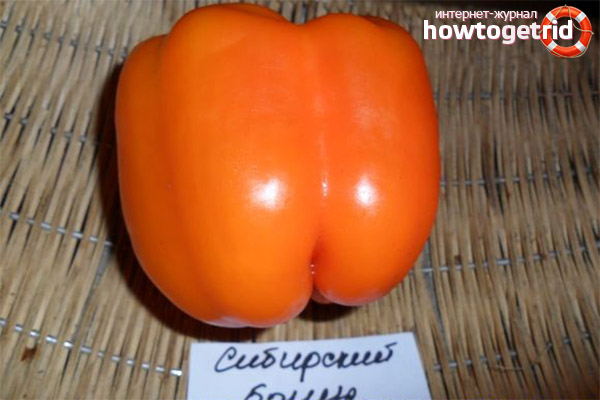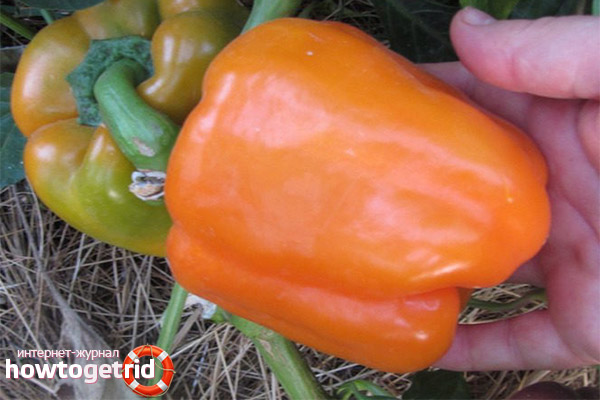The content of the article
Pepper Siberian bonus refers to mid-season varieties, harvesting can be done for 110 days from the moment of transplanting seedlings into the ground or greenhouses. Fruits have fairly thick and fleshy walls, have a pleasant orange tint, and are distinguished by high palatability. A variety of universal purpose. In regions with a cold climate, they are grown in glazed greenhouses.
Grade description
The bush does not grow tall, as a rule, no more than 85 cm. The plant has a compact, closed shape, foliage hides a copious amount of ovaries, which, in a state of technical maturity, almost completely merge with the thick cover of the plant.
Sor Siberian bonus can be quite successfully grown both indoors and outdoors. With proper care and favorable conditions, up to fifteen large fruits with a wall thickness of about 10 mm are formed on the bush. These fruits are ideal for fresh consumption, as well as for canning and stuffing. Also, peppers can be frozen, if desired, dried.
If you grow a crop for the purpose of further realization, plan its further transportation, then it is recommended to harvest it while the fruits are in a state of technical maturity.
With proper agricultural technology, up to three kilograms of product can be collected from one bush. For abundant fruiting, it is necessary to observe the so-called regime of mineral nutrition and watering.
Growing and planting
Growing seedlings begin approximately 65 days before the expected time of planting. The first step is to make a selection of seeds. Pour them with a glass of water. Those that come up can be considered marriage.
- Then it is necessary to carry out the procedure of hardening seeds in an unconcentrated solution of potassium permanganate. This procedure will further protect plants from the appearance of fungal diseases. At the end of hardening, the seeds should be put on wet gauze, left for a couple of hours, until properly swollen.
- Seedlings need to be grown in small peat pots, since the root system of this crop develops rather slowly.
- When sowing pepper seeds, in no case do not deepen too deep into the soil, as this can slow down the development of the plant.
- About two weeks before planting in the open ground, it is recommended that the plants be taken outside for a couple of hours.
- If there is a lack of light, use additional lamps, the backlight should be produced in the same way at night.
- It is necessary to add a little sand to the soil for seedlings, this will make the soil more loose and allow the seeds to germinate faster. The first weeks of the pots cover with cling film.
- When four leaves appear on the seedlings, it can be planted in open ground. The ideal time for this is the last decade of May. Remember that pepper is a thermophilic culture that does not tolerate even short-term frosts.
- On one square meter should not be more than three copies. It is also worth remembering that this culture does not like windy open areas, and feels uncomfortable on them. For bell peppers, it is worthwhile to find the most protected places from the wind.
- When planting, the wells into which the transplant will be carried out are watered abundantly. The crop will not bear fruit on acidic and overly poor soils. The ideal precursors for the Siberian bonus pepper are such crops: cucumber, cabbage, onions, and legumes.
- Ammonium nitrate can be added to the soil, calculated at 40 grams per square meter.
The final stage of soil preparation is saturation with copper sulfate solution. For one bucket of water, you need to take one tablespoon of the substance. This treatment will protect the plants from fungal diseases.
Care
An important component of pepper care is watering. This culture does not like drought, but also does not favor excess water. Excessive waterlogging can lead to fungal diseases, and decay of the plant.
Watering directly under the root, otherwise it can cause sunburn.
The plant will have to be watered somewhat more abundantly during flowering and fruit setting.
Do not forget about such an important procedure as stepsoning. It will help direct all the energy into the fruits, and not on the development of the green mass of the bush. With all its advantages, it is worth remembering that removing the stepsons is too often harmful to the plant. For one approach, in no case should you remove more than three stepsons, otherwise you can seriously injure the bush.
A crop will not produce a large crop if cultivation is carried out on poor soils. For this reason, the soil constantly needs to be fed with complex fertilizers.
Procedures such as hilling and loosening the soil produce at least four times per season. But when loosening, one should not go too deep into the soil, there is a risk of damage to the root system.
Pros and cons of the variety
The positive qualities of this variety include:
- high yields
- pleasant aroma,
- the possibility of ripening after harvest,
- resistance to transportation,
- unpretentiousness in leaving,
- meat flesh.
With proper agricultural technology and proper care, you will get an excellent harvest.
Diseases and Pests
Most often, bell pepper is exposed to such diseases:
- late blight,
- white and vertex rot,
- Septoria,
- macrosporiosis.
The greatest harm to the culture is caused by slugs, scoop, aphids and the Colorado potato beetle. In order to protect the plant from the attack of the bear, before planting the hole, it is necessary to pour plenty of water. Wood ash is also a good remedy; on average, peppers need to be pollinated with it at least three times per season.
To get rid of the suddenly attacked aphids, pepper should be treated with whey (in the ratio of one and a half liters per bucket of water). After this procedure, sprinkle the plants with a small amount of ash.
Video: what peppers can ripen without a greenhouse even in Siberia











Submit